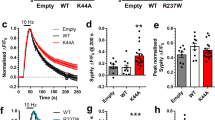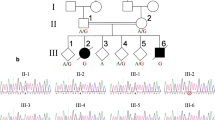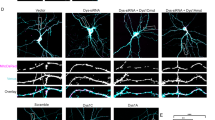Abstract
Mitochondrial fission and fusion are dynamic processes vital to mitochondrial quality control and the maintenance of cellular respiration. In dividing mitochondria, membrane scission is accomplished by a dynamin-related GTPase, DNM1L, that oligomerizes at the site of fission and constricts in a GTP-dependent manner. There is only a single previous report of DNM1L-related clinical disease: a female neonate with encephalopathy due to defective mitochondrial and peroxisomal fission (EMPF; OMIM #614388), a lethal disorder characterized by cerebral dysgenesis, seizures, lactic acidosis, elevated very long chain fatty acids, and abnormally elongated mitochondria and peroxisomes. Here, we describe a second individual, diagnosed via whole-exome sequencing, who presented with developmental delay, refractory epilepsy, prolonged survival, and no evidence of mitochondrial or peroxisomal dysfunction on standard screening investigations in blood and urine. EEG was nonspecific, showing background slowing with frequent epileptiform activity at the frontal and central head regions. Electron microscopy of skeletal muscle showed subtle, nonspecific abnormalities of cristal organization, and confocal microscopy of patient fibroblasts showed striking hyperfusion of the mitochondrial network. A panel of further bioenergetic studies in patient fibroblasts showed no significant differences versus controls. The proband’s de novo DNM1L variant, NM_012062.4:c.1085G>A; NP_036192.2:p.(Gly362Asp), falls within the middle (oligomerization) domain of DNM1L, implying a likely dominant-negative mechanism. This disorder, which presents nonspecifically and affords few diagnostic clues, can be diagnosed by means of DNM1L sequencing and/or confocal microscopy.
Similar content being viewed by others
Log in or create a free account to read this content
Gain free access to this article, as well as selected content from this journal and more on nature.com
or
References
Archer SL : Mitochondrial dynamics - mitochondrial fission and fusion in human diseases. N Engl J Med 2013; 369: 2236–2251.
Itoh K, Nakamura K, Iijima M, Sesaki H : Mitochondrial dynamics in neurodegeneration. Trends Cell Biol 2013; 23: 64–71.
Labrousse AM, Zappaterra MD, Rube DA, van der Bliek AM : C. elegans dynamin-related protein DRP-1 controls severing of the mitochondrial outer membrane. Mol Cell 1999; 4: 815–826.
Smirnova E, Griparic L, Shurland DL, van der Bliek AM : Dynamin-related protein Drp1 is required for mitochondrial division in mammalian cells. Mol Biol Cell 2001; 12: 2245–2256.
Smirnova E, Shurland D-L, Ryazantsev SN, van der Bliek AM : A human dynamin-related protein controls the distribuition of mitochondria. J Cell Biol 1998; 143: 351–358.
Wakabayashi J, Zhang Z, Wakabayashi N et al: The dynamin-related GTPase Drp1 is required for embryonic and brain development in mice. J Cell Biol 2009; 186: 805–816.
Berthet A, Margolis EB, Zhang J et al: Loss of mitochondrial fission depletes axonal mitochondria in midbrain dopamine neurons. J Neurosci 2014; 34: 14304–14317.
Oettinghaus B, Schulz JM, Restelli LM et al: Synaptic dysfunction, memory deficits and hippocampal atrophy due to ablation of mitochondrial fission in adult forebrain neurons. Cell Death Differ 2015; e-pub ahead of print 24 April 2015; doi:10.1038/cdd.2015.39.
Shields LY, Kim H, Zhu L et al: Dynamin-related protein 1 is required for normal mitochondrial bioenergetic and synaptic function in CA1 hippocampal neurons. Cell Death Dis 2015; 6: e1725.
Waterham HR, Koster J, van Roermund CW, Mooyer PA, Wanders RJ, Leonard JV : A lethal defect of mitochondrial and peroxisomal fission. N Engl J Med 2007; 356: 1736–1741.
Yoon G, Malam Z, Paton T et al: G.O.6: Lethal disorder of mitochondrial fission caused by mutations in DNM1L. Neuromuscul Disord 2014; 24: 794, (abstract).
Liu H, Sawyer SL, Gos M et al: Atypical fibrodysplasia ossificans progressiva diagnosed by whole-exome sequencing. Am J Med Genet Part A 2015; 9999: 1–5.
Invernizzi F, D’Amato I, Jensen PB, Ravaglia S, Zeviani M, Tiranti V : Microscale oxygraphy reveals OXPHOS impairment in MRC mutant cells. Mitochondrion 2012; 12: 328–335.
Adzhubei IA, Schmidt S, Peshkin L et al: A method and server for predicting damaging missense mutations. Nat Methods 2010; 7: 248–249.
Exome Aggregation Consortium [http://exac.broadinstitute.org] (accessed August 2015).
Kumar P, Henikoff S, Ng PC : Predicting the effects of coding non-synonymous variants on protein function using the SIFT algorithm. Nat Protoc 2009; 4: 1073–1081.
Chang CR, Manlandro CM, Arnoult D et al: A lethal de novo mutation in the middle domain of the dynamin-related GTPase Drp1 impairs higher order assembly and mitochondrial division. J Biol Chem 2010; 285: 32494–32503.
Imoto M, Tachibana I, Urrutia R : Identification and functional characterization of a novel human protein highly related to the yeast dynamin-like GTPase Vps1p. J Cell Sci 1998; 111: 1341–1349.
Acknowledgements
We acknowledge the participation of the proband and his family, without whom this work would not be possible. This work was supported by MitoCanada Foundation and was performed, in part, under the Care4Rare Canada Consortium funded by Genome Canada, the Canadian Institutes of Health Research (CIHR), the Ontario Genomics Institute, Ontario Research Fund, Genome Quebec, and CHEO Foundation. We thank Taila Hartley (Clinical Coordinator) and Chandree Beaulieu (Project Manager) at the Children’s Hospital of Eastern Ontario (CHEO) Research Institute for their contribution to the infrastructure of Care4Rare. This work was selected for study by the Care4Rare (Enhanced Care for Rare Genetic Diseases in Canada) Consortium Gene Discovery Steering Committee: Kym Boycott (lead; University of Ottawa), Alex MacKenzie (co-lead; University of Ottawa), Jacek Majewski (McGill University), Michael Brudno (University of Toronto), Dennis Bulman (University of Ottawa), and David Dyment (University of Ottawa). We acknowledge the contribution of the high-throughput sequencing platform of the McGill University and Génome Québec Innovation Centre, Montréal, Canada. MT received a post-doctoral fellowship from the CIHR. GA received a Vanier Canada Graduate Scholarship. M-EH is funded by the CIHR (INMD; MOP 57810). DAD is supported by the CIHR Institute of Genetics Clinical Investigatorship Award.
Author information
Authors and Affiliations
Consortia
Corresponding author
Ethics declarations
Competing interests
The authors declare no conflict of interest.
Additional information
Supplementary Information accompanies this paper on European Journal of Human Genetics website
Supplementary information
Rights and permissions
About this article
Cite this article
Vanstone, J., Smith, A., McBride, S. et al. DNM1L-related mitochondrial fission defect presenting as refractory epilepsy. Eur J Hum Genet 24, 1084–1088 (2016). https://doi.org/10.1038/ejhg.2015.243
Received:
Revised:
Accepted:
Published:
Issue date:
DOI: https://doi.org/10.1038/ejhg.2015.243
This article is cited by
-
A novel variant of DNM1L expanding the clinical phenotypic spectrum: a case report and literature review
BMC Pediatrics (2024)
-
Clueless/CLUH regulates mitochondrial fission by promoting recruitment of Drp1 to mitochondria
Nature Communications (2022)
-
A new automated tool to quantify nucleoid distribution within mitochondrial networks
Scientific Reports (2021)
-
Dynamic-related protein 1 inhibitor eases epileptic seizures and can regulate equilibrative nucleoside transporter 1 expression
BMC Neurology (2020)
-
DNM1L Variant Alters Baseline Mitochondrial Function and Response to Stress in a Patient with Severe Neurological Dysfunction
Biochemical Genetics (2018)



